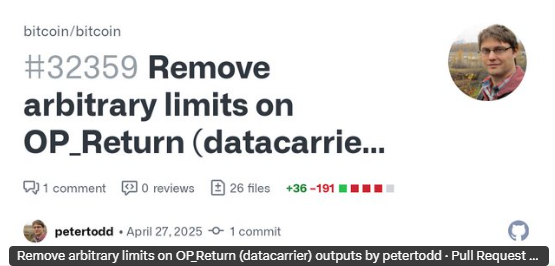Bitcoin Core developer Peter Todd proposed removing arbitrary size limits on OP_RETURN, igniting an intense debate. The entire debacle reveals deep divisions over Bitcoin’s purpose and future.
OP_RETURN is the operation code (opcode) that allows small data payloads to be embedded in Bitcoin (BTC) transactions.
Bitcoin Core Developers and Community Clash Over OP_RETURN Limits
Peter Todd’s proposal #32359 on GitHub would lift long-standing restrictions on how much data can be stored using OP_RETURN, which is currently capped at 80 bytes.
One of Satoshi Nakamoto’s theories’ candidates, Peter Todd, argues that the change would simplify Bitcoin’s codebase. The cryptography developer also highlights its potential to improve efficiency without endangering the network.
As OP_RETURN outputs are unspendable, they do not bloat the Unspent Transaction Output (UTXO) set that all Bitcoin full nodes must track for transaction validation.
“The restrictions are easily bypassed by direct substitution and forks of Bitcoin Core,” Todd noted in his GitHub comments.

According to Peter Todd, formalizing higher limits would reflect existing practices and benefit use cases like sidechains and cross-chain bridges.
Many in the Bitcoin community view the change as a dangerous shift toward non-monetary use cases for the pioneer crypto. This is reminiscent of the 2014 OP_RETURN Wars when spam concerns forced developers to reduce the data cap from 80 to 40 bytes before raising it again.
That era saw services like Veriblock flood the chain with data, leading to increased block sizes and transaction fees.
“Sidechain builders shouldn’t influence Bitcoin Core. Bitcoin on its base layer is money and should be only focused on money,” warned Willem S, founder of Botanix Labs.
Willem argues that changing standard rules to make development easier sets a troubling precedent, particularly when workarounds already exist.
Proposal Is A Betrayal of Bitcoin’s Fundamental Principles, Critics Say
Meanwhile, critics call the proposal a betrayal of Bitcoin’s foundational principles. One such critic is Jason Hughes, who works in development and engineering at Ocean Mining. He accuses developers of steamrolling dissent and ignoring broader user concerns.
Hughes said the change could push Bitcoin toward being a worthless altcoin.
“Bitcoin Core developers are about to merge a change that turns Bitcoin into a worthless altcoin, and no one seems to care to do anything about it. I’ve voiced objections, lost sleep over this, and despite clear community rejection of the PR it’s moving,” Hughes lamented.
Nevertheless, others are more optimistic, with some acknowledging the potential of this move to drive network improvement.
“Catering to applications such as sidechains and bridges drives more transactions, which is good for the network,” countered Karbon, a popular user on X.
This sentiment hinges on the assumption that people already bypass the limit anyway. The backlash also stirred broader philosophical objections, with some likening it to the ongoing Ethereum woes.
“Bitcoin should not follow an ‘L2-centric’ roadmap. It is actually, what killed Ethereum. Bitcoin is money and should be focused on that,” another user argued.
Amidst debates on the technical merits of the change, the social impact may be harder to contain.
The proposal has amplified long-simmering concerns over developer centralization and revisited the risk of alienating users who believe Bitcoin should remain a minimal, sovereign monetary protocol.
Whether the proposal moves forward or stalls, the controversy reveals the growing tension between Bitcoin’s purist roots and the pressure to evolve.
The post Peter Todd’s Bitcoin OP_RETURN Limit Proposal Causes Rift Between Core Developers and Community appeared first on BeInCrypto.








